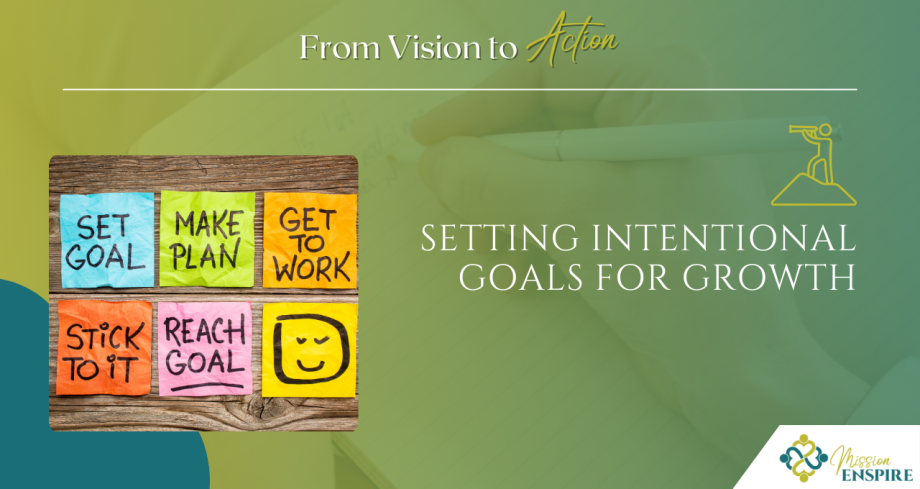In my last post, we explored the power of hope and how it fuels growth. Hope allows us to believe in what’s possible, but without action, hope alone is not enough. To bring our dreams to life, we must pair that hope with intention, strategy, and follow-through. That’s where goal-setting comes in—not just any goals, but intentional goals that align with our values and purpose. Setting goals is more than writing down a to-do list or making vague resolutions. It’s about creating a roadmap that leads to meaningful progress. I’ve learned this firsthand in both my career and personal life—without clear goals, it’s easy to feel stuck, overwhelmed, or uncertain about the next step. But when we set intentional goals and take purposeful action, we create momentum that propels us forward.
I remember when I launched Mission ENSPIRE, a vision that had been in my heart for a while. The idea of stepping out as an entrepreneur and creating a platform that empowered women and nonprofit leaders was both exciting and terrifying. I questioned whether I was truly ready, whether I had the resources, and whether people would see the value in what I was offering. But I knew that if I waited until I felt fully ready, I would never take the leap. So, I set an intentional goal: to officially launch, establish my services, and build a community of support. Taking that first step was daunting, but each milestone—from my first client to my first workshop—helped reinforce that this was the path I was meant to walk. Looking back, I see how that one decision transformed my confidence and leadership in ways I couldn’t have imagined.
Why Intentionality Matters in Goal-Setting
Many people set goals, but not all goals lead to real change. The difference lies in intentionality—the conscious decision to pursue a goal because it aligns with your deeper purpose. Intentionality ensures that you’re not just busy, but productive in ways that matter. Think about a time when you set a goal but didn’t follow through. What happened? More than likely, it wasn’t because you lacked ability, but because the goal wasn’t deeply connected to what truly motivated you.
Characteristics of Intentional Goals:
- They align with your values and long-term vision.
- They challenge you to grow while remaining achievable.
- They have clear, actionable steps.
- They allow flexibility for learning and adjustment.
Intentional goals help us focus on what truly matters instead of getting caught up in distractions or societal expectations. As Proverbs 16:3 says, “Commit to the Lord whatever you do, and he will establish your plans.” Aligning your goals with a deeper purpose brings clarity and direction.
Overcoming Common Roadblocks to Taking Action
Even with the best intentions, we all face challenges when trying to achieve our goals. Here are some of the most common roadblocks and how to overcome them:
- Fear of Failure – Many people hesitate to take action because they fear making mistakes. But failure is not the opposite of success—it’s part of the journey. Instead of seeing setbacks as signs to stop, view them as opportunities to learn and adjust.
- Reframe your mindset: Instead of saying, “What if I fail?” ask, “What can I learn from this experience?”
- Scriptural encouragement: Isaiah 41:10 says, “So do not fear, for I am with you; do not be dismayed, for I am your God.” Let faith guide your steps.
- One of the biggest roadblocks I faced was fear of failure when stepping into public speaking. I have always felt comfortable facilitating and training, but when I was asked to speak at a major event, self-doubt crept in. Would my message resonate? Was I qualified enough? That fear nearly held me back, but instead of letting it paralyze me, I broke the goal into smaller, manageable steps. I practiced, sought feedback from trusted mentors, and reminded myself that I was called to this moment for a reason. The event was a learning experience for me. While I did okay, I realized there were areas I could improve. But instead of seeing it as a failure, I treated it as a steppingstone. It reinforced the lesson that courage isn’t the absence of fear—it’s moving forward despite it and learning along the way.
- Lack of Clarity – If your goals feel overwhelming or vague, break them down into smaller, actionable steps. The clearer your goal, the easier it is to take the first step.
- Practical tip: Use the SMART goal framework—Specific, Measurable, Achievable, Relevant, and Time-bound.
- Procrastination – Sometimes, we delay taking action because we’re waiting for the “perfect” time. But progress isn’t about perfection; it’s about consistency.
- Practical tip: Set micro-goals to build momentum. Commit to just five minutes of focused work, and you’ll often find it easier to continue.
- External Pressures and Distractions – It’s easy to get sidetracked by other people’s expectations or daily distractions. The key is to regularly revisit your goals and remind yourself why they matter.
- Practical tip: Create a vision board or journal to keep your goals top-of-mind.
Practical Steps to Move from Vision to Action
- Define Your Why – Why does this goal matter to you? Connecting your goal to a deeper reason will increase your commitment.
- Example: Instead of saying, “I want to get healthier,” clarify, “I want to improve my health so I can have more energy and longevity for my family and purpose.”
- Write Down Your Goals – Studies show that people who write down their goals are significantly more likely to achieve them.
- Tip: Keep your goals somewhere visible as a daily reminder.
- Create an Action Plan – Break down your goal into smaller steps and set deadlines for each milestone.
- Example: If your goal is to write a book, set a schedule for outlining chapters, writing drafts, and revising content.
- Build Accountability – Share your goals with a trusted friend, mentor, or coach who can provide encouragement and hold you accountable.
- Tip: Join a mastermind group or community where you can support one another.
- Track Your Progress and Adjust – Regularly reflect on what’s working and what needs adjustment.
- Journal prompt: What progress have I made in the last month, and what is my next best step?
- Celebrate Small Wins – Acknowledge progress along the way to stay motivated.
- Example: If your goal is to improve public speaking skills, celebrate each presentation or speech you complete, even if it’s a small one.
Faith and Vision: Trusting the Process
As you move from vision to action, remember that success is a journey, not an overnight event. There will be setbacks and moments of doubt, but perseverance is key. Romans 8:28 reminds us, “And we know that in all things God works for the good of those who love him, who have been called according to his purpose.” Trust that your efforts, when aligned with your faith and purpose, will lead to meaningful growth.
Putting Vision into Motion
Taking the first step can feel overwhelming, especially when we’re stuck in patterns of perfectionism or fear. That’s something I continue to work through myself—learning to embrace progress, not perfection, as I shared in From Perfectionist to Progress-Seeker. Growth doesn’t happen all at once; it unfolds in small, meaningful ways. Those micro habits, those tiny shifts? They matter. I wrote more about that in The Power of Tiny Steps, where I explored how even five minutes of effort can build the momentum you need. Pairing those small actions with courage, as discussed in The Courage-Confidence Connection, transforms hesitation into forward motion.
Throughout this past year, I’ve leaned deeply into intentionality, gratitude, and purpose—as reflected in Chapter 48: Embracing Growth, Gratitude, and New Possibilities. And at the core of it all is mindset. Positive Mindset and Growth reminds us that before we see change outside, we must nurture belief within. That’s why I’m inviting you to take one intentional step—just one—that moves you closer to the life you envision. Write the goal. Make the call. Show up. Let each action be anchored in belief and purpose. Because with every step you take, no matter how small, you’re building a life aligned with your values, your courage, and your vision. In the next post, we’ll explore how to deepen your self-belief and cultivate the mindset that carries you forward—even when doubt or fear show up along the way.
So tell me, what’s one step you can take today to move closer to the life you envision?

